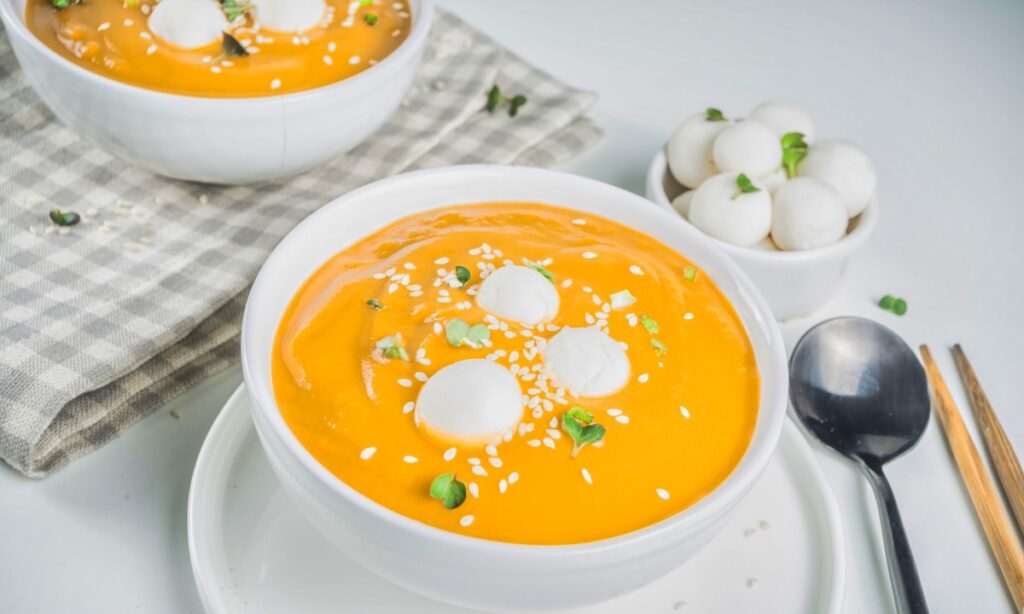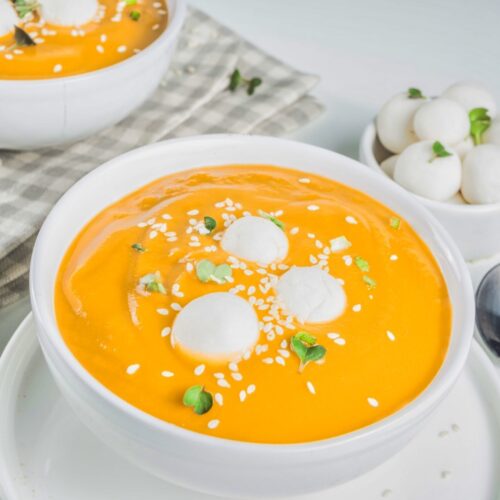
Table of Contents
Hobak-juk, or Korean pumpkin porridge, call it by any name, is a popular dessert/snack loved by so many people around the world, especially in Korea. Some of the people even prefer eating this dish for breakfast. It has a sweet & nutty flavor and has a velvety texture. It is an ideal comfort food for the late fall and winter seasons.
Hobak-juk, the pumpkin porridge, is generally prepared using aged pumpkin, i.e., neulgeun hobak, which has been matured for a really long period of time. Plus, the sweet pumpkin, which is known as danhobak, is popularly utilized for making pumpkin porridge.
The rice cake balls are another highlight of this Korean Hobak-juk recipe. Many people also refer to these rice balls as rice dumplings. Rice cake balls are made of sweet rice flour, and it has a jelly-like texture which makes them more fun to consume along with the pumpkin porridge.
Exceptionally, in Korea, all these rice cake balls are known as “Saealsim.” This particular term means – bird’s egg. It is probably quoted like this because they look like tiny eggs of birds.
Now that you understand the basics of Hobak-juk, let’s get ready to prepare this amazing Korean dish. I hope that you enjoy this recipe as much as I do, and with just a few ingredients, you can make yourself and your family cozy this winter!
How To Make Hobak-juk (Pumpkin Porridge)

Hobak-juk (Pumpkin Porridge) Recipe
Equipment
- A Large Pot
- Cups
- Blender
- Tablespoons
- Potato Masher
Ingredients
For Hobak-juk
- 1 Kabocha Or Small Pumpkin of about 2 Pounds
- ½ Cup Sweet Rice i.e., Glutinous rice, must be soaked in the water for about an hour (Or Use ½ Cup Sweet Rice Flour Combined with 1 Cup Of Water)
- ½ Teaspoon Salt
- 1 – 2 tbsp Brown Sugar Adjust According To Your Taste, Or You Can Just Skip It
For Rice Balls ( Optional)
- ½ Cup Sweet Rice Flour Chapssal garu Or Mochiko
- ¼ tsp Salt
- 2 tsp Sugar
For Garnishing (Optional)
- ¼ Cup Red Beans (It Must Be Pat Soaked and Boiled)
- 1 tbsp Pumpkin Seeds, Pine Nuts, and jujubes (If available, Pecans and Walnuts Can Be A Great Option Too)
Instructions
For Making Hobak-juk (Pumpkin Porridge)
- First, cut the kabocha squash into quarters or halves, as you prefer. Remove all the seeds and put the squash into a large pot. Add about 6 cups of water; it must be one-third way above the squash.
- Cover the lid and boil it over medium to high heat until the kabocha becomes tender. Let it boil for about 25 to 30 minutes. Now, remove the water and allow the squash to cool down.
- When you feel that the squash is cool enough to deal with, take out the flesh, or you can just peel off the skin.
- Use a blender to make a smooth paste of the cooked squash at this juncture. If needed, you can add a few tablespoons of water to blend smoothly. Or else, you can also make use of an immersion blender, and gently mash it using a spoon or a potato masher, if you like to let some squash lumps remain in the porridge.
- In a blender, add the soaked glutinous rice and 1 cup of water and grind it properly.
- Now, pour the blended sweet rice into the pot of the already-cooked squash. Add 3 cups of water to the pot.
- Cook it over medium heat. Keep stirring until the rice comes to be translucent and the porridge turns thick.
- Next, turn the heat to low and cover the lid. Let it simmer and stir occasionally. Do this for at least 20 minutes. At this point, you can adjust the consistency of the pumpkin porridge according to your preference.
- Add salt, brown sugar, and red beans (cooked optionally). Cook the porridge for 3 to 4 minutes more, and it’s ready!
For Making Rice Balls (Optional)
- Take a medium-sized bowl, and add rice powder, sugar, and salt. Mix it well.
- Add 4 tablespoons of boiling hot water. While adding the water, keep stirring. When it becomes cool enough for dealing, start kneading using your hands to form a dough. However, you can also use coconut water instead of water to cook the sweet rice, which will give the pumpkin porridge a creamier texture and a hint of coconut flavor.
- Now, you have to give the dough a ¾-inch cylinder-like shape. Cut that into ¾ inch pieces. Roll each & every piece between your palms in order to make a small ball.
- Take a pot, add water, and bring it to a boil. Put in the rice cake balls and cook until they start floating. Move them to a large-sized bowl that has cold water. Let them cool, then drain out the water.
To Serve
- Spoon out some Hobak-juk into a serving bowl. Serve the hot pumpkin porridge with a few optional garnishes and rice cake balls.
Notes
- What’s more, you can also sprinkle some pumpkin seeds, pine nuts, or jujubes (daechu) to give it a nutty flavor. However, these are optional.
- People also like to add cooked pat, i.e., adzuki beans, to the Hobak-juk dish. If you want, you can also go for this.
- Try to make smaller rice cake balls as it tastes better and helps in balancing out nicely in regard to the quantity of the Hobak-juk.
- Typically, it is prepared using a kabocha as it has a sweet flavor and bright color. However, as an alternative, you can also use any orange-fleshed winter pumpkin or squash.
- If you have a microwave, then you can place the kabocha halves in the microwave and cook them without covering them for 10 to 15 minutes until it becomes soft.
- If you have some pumpkin porridge leftover, then you can just pour it into an airtight container and refrigerate it for 1 – 2 days.
- For some added flavor, you can add some spices such as ginger, cardamom, saffron, cinnamon or nutmeg to the pumpkin porridge while it’s cooking.
- Also, instead of utilizing brown sugar, you can use maple syrup, honey or agave nectar to sweeten the porridge.
- To give prices balls an interesting twist, you can add some chopped dry fruits, nuts, or sweetened red bean paste to the filling.
Conclusion
If you are in search of a sweet dish, this can be the ideal one for you! It’s warm, comforting, creamy, and extremely light to the stomach. In addition, I am truly fond of Korean dishes, and that’s why I love to share these amazing recipes with you guys. Are you also with me on this one? If yes, I would be more than to know! So, if you cook Hobak-juk for yourself or your family, I would love to read your thoughts about this special dish. Feel free to express your thoughts in our comment section below. Enjoy!
FAQ
What Is The Meaning Of Hobak In Korean?
Hobak is a Korean term, which is utilized for pumpkin, zucchini, and squash. But we talk about Hobak-juk. It is generally made with danhobak, which is popularly known as kabocha squash (Japanese Pumpkin) and kent pumpkin in some of the countries.
Is Hobak-juk (pumpkin porridge) a good dish for babies?
Hobak-juk is fully packed with fiber, and significant minerals. It is a perfect way to boost immunity, and it supports healthy weight gain in small babies.
How many calories does Hobak-juk contain?
Hobak-juk (1 serving) contains 41g net carbohydrates, 44g total carbs, 4g protein, 3g fat, and 211 calories.
Is Hobak-juk an ideal dish for weight loss?
In simple words, pumpkin is truly considered to be weight-loss friendly food as you can eat it better than other carbs sources such as potatoes and rice but still put up with fewer calories. In addition, pumpkin is actually an amazing source of fiber, and this can help curb the appetite.